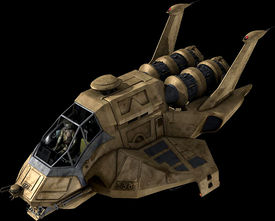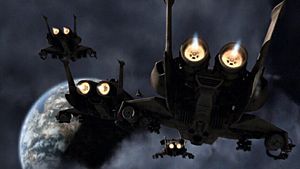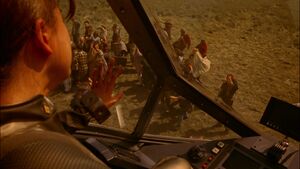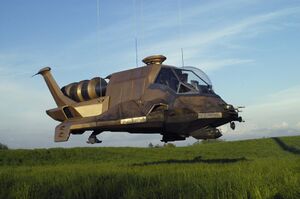Ancient Kobolian: Galleon
Raptor: Difference between revisions
More languages
More actions
m rm tally link |
mNo edit summary |
||
| Line 127: | Line 127: | ||
[[Category:Colonial Military]] | [[Category:Colonial Military]] | ||
[[Category:Colonial Military (RDM)]] | [[Category:Colonial Military (RDM)]] | ||
[[Category:Raptors]] | [[Category:Raptors|*]] | ||
[[Category:Ships]] | [[Category:Ships]] | ||
[[Category:Ships (RDM)]] | [[Category:Ships (RDM)]] | ||
Revision as of 17:03, 1 July 2008
The Raptor is a vehicle utilized by the Colonial military. While it is designed to perform multiple roles, the Raptor most commonly takes part in reconnaissance and scouting operations.
| Raptor | |||
|---|---|---|---|

| |||
| [show/hide spoilers] Spoilers hidden in infobox by default only. | |||
| Race: | Colonial | ||
| Type: | Military | ||
| FTL: | Yes (short range) | ||
| Propulsion: | |||
| Crew: | 2 (Pilot and ECO) | ||
| Capacity: | Approximately 5-10 passengers | ||
| CO: | {{{co}}} | ||
| XO: | {{{xo}}} | ||
| Role: | Reconnaissance and surveillance, electronic countermeasures support, transport | ||
| Weapons: | Missiles and bombs (special missions only); normally unarmed; decoys | ||
| Armaments: | {{{arm}}} | ||
| Defenses: | {{{def}}} | ||
| Aircraft: | {{{aircraft}}} | ||
| Aviation facilities: | {{{facilities}}} | ||
| Emblem: | [[File:{{{patch}}}|175px|Ship's patch]] | ||
| Other Images: | Gallery | ||
| Length: | 28 feet (8.6m) | ||
| Width: | {{{width}}} | ||
| Height: | 9.5 feet (2.9m) | ||
| Weight: | 50 tons [1] | ||
| Wingspan: | 18.34 feet (5.6m) | ||
| Other: | {{{otherdi}}} | ||
| Cost: | {{{construction}}} | ||
| Construction Time: | {{{construction}}} | ||
| Hull Size: | {{{hull size}}} | ||
| Hull: | {{{hull}}} | ||
| FTL Cooldown: | {{{ftl cooldown}}} turns | ||
| Speed: | {{{speed}}} m/s | ||
| Turn Rate: | {{{turn rate}}}°/turn | ||
| Armor Total: | {{{armor total}}} | ||
| Armor Left: | {{{armor left}}} | ||
| Armor Right: | {{{armor right}}} | ||
| Armor Front: | {{{armor front}}} | ||
| Armor Rear: | {{{armor rear}}} | ||
| Armor Top: | {{{armor top}}} | ||
| Armor Bottom: | {{{armor bottom}}} | ||
| DRADIS Range: | {{{dradis range}}} m | ||
| Processing Power: | {{{processing power}}} | ||
| Munition Slots: | {{{munitions}}} | ||
| Munition Cooldown Period: | {{{munition cooldown}}} turns | ||
| Squadron Slots: | {{{squadrons}}} | ||
| Squadron Size: | {{{squadron size}}} | ||
| Special Abilities: | {{{special abilities}}} | ||
| Additional Information | |||
Overview
The Raptor is usually operated by a crew of two (one pilot and one ECO), has synthetic gravity on board, and is controlled by means of a fly-by-wire system (Rapture). It is capable of atmospheric flight and is also equipped with a short-range FTL engine, allowing it to make short faster-than-light hops. Due to its size and shape, a Raptor is not launched from a battlestar's launch tube, rather, it deploys from the forward end of a flight pod. The vehicle has been a mainstay of the Colonial fleet for over 40 years, having entered service sometime prior to the twelfth year of the first Cylon War (Razor Flashbacks, Episode 3).
As a scout, Raptors can:
- Undertake short and medium-range scans to detect electromagnetic, heat or other signatures from other vessels
- Scan planetary surfaces for signs of life, energy output, or to locate and assess mineral deposits ("Water", "The Hand of God")
- Scout ahead of its parent warship in other planetary or celestial systems for any signs of hostile intent or stellar conditions prior to the parent ship's arrival (Miniseries)
- Undertake search & rescue operations after an engagement with Cylon forces.
When scouting, Raptors can operate independently, or in concert with other Raptors and Vipers (The Hand of God).
As an ECM platform, the Raptor contains a full suite of electronic countermeasure and monitoring tools, enabling it to:
- Jam wireless or relay transmissions (by wireless or optically) from other spacecraft (Miniseries, "33")
- Scramble control signals used by guided weapons (Miniseries)
- Undertake IFF operations for Viper squadrons (Miniseries)
In addition to reconnaissance and scouting, the Raptor can also undertake the following roles:
- Airborne warning & control and electronic countermeasures platform supporting Viper operations (Miniseries, "33")
- Marine assault craft ("Bastille Day", "Kobol's Last Gleaming, Part II", "Pegasus")
- Ambulance / evac vehicle (Miniseries)
- General purpose transport ("Flesh and Bone", "Tigh Me Up, Tigh Me Down", "Home, Part II")
- Combat Search and Rescue ("Fragged", "Resurrection Ship, Part II")
- Secure communication with other vessels (33)
In the transport role, a Raptor is capable of carrying around eight to ten adults in addition to the two-person crew. In the assault role, it can carry a squad of some eight equipped Marines (Bastille Day).
Atmospheric Operations
The Raptor is designed for atmospheric as well as space-based operations. However, a critical element for atmospheric operations is that to remain airborne requires fuel: once in an atmosphere, the engines must be run constantly to maintain lift and to hover. Depending on the composition of the atmosphere itself, this can place severe strain on the Raptor's engines (You Can't Go Home Again).
Due to their overall configuration and bulk, Raptors may also suffer from poor handling at low speeds, and rely heavily on directed thrust to remain airborne.
FTL Operations
A Raptor seems to be able to make at least ten, and probably at least 20 FTL jumps before refueling as seen in "Lay Down Your Burdens, Part I". However, these Raptors had been carrying more than a typical amount of fuel for that mission.
Life Support
The main flight deck / cabin of a Raptor is fully pressurized. However, crews operate in flight suits and helmets to help protect them against any hull breach (Miniseries). The cabin can also be depressurized and used in space rescue operations. Re-pressurization takes 10 seconds ("You Can't Go Home Again", "A Day in the Life"). The forward pilot and co-pilot seats can eject in an emergency as the forward canopy is blown away prior to the ejection (Dirty Hands).
Propulsion
Armament

Offensive
Raptors are normally unarmed as they make for a poor general-purpose fighter. The craft have an internal weapons bay capable of holding both offensive and defensive weapons. They are also capable of carrying heavy external armaments on four wing hardpoints, two wingtip hardpoints, and two fuselage hardpoints on the sides of the Raptor's body. Known weapons carried include:
- nuclear missiles
- bombs/munitions pods
- quad racks of missiles
- multiple-tube rocket batteries mounted on the fuselage points
- external cannons
Defensive
The Raptor's contours provide it a reduced DRADIS signature to avoid detection. In addition, the craft carry an assortment of pods to aid in communications or defense as well as electronic countermeasures such as a jigger.[2]
- Up to 6 decoy drones
- Up to 4 communication drones
- Up to 4 sets of flares
- Up to 4 chaff pods
Layout

The Raptor is an angular vehicle built for purpose, not style. The forward section of the Raptor contains a flight cabin with adjacent seats for the pilot and ECO (who occupies the rear section of the vehicle during non-military operations). The flight cabin is directly connected to the main body of the vehicle, where bulkhead-mounted columns of electronics sensory equipment are found. A large canopy at the bow provides favorable forward and side visibility for the crew, and is beneficial when a quick scan of immediate surroundings is required.
A large hydraulic door mounted to the port side of the vehicle provides general ingress and egress to the vehicle. In addition, a floor-mounted hatchway provides a further point of egress. The central door is linked to a pressurized docking skirt that can be extended from the underside of a Raptor, enabling it to dock to the hulls of other vessels. In the case of an assault, marines can use the skirt to breech a hull and board a hostile vessel (Bastille Day).
Aft of the pressurized area are the FTL engine and main sublight engines. Port and starboard stub wings provide additional lift during atmospheric flight, and winglets reduce drag and provide step access to the wings and hull. RCS thrusters are placed throughout the craft for landing, maneuvering and stabilization (Miniseries).
Notes
- "Raptor" is a Latin word meaning bird of prey.
- Commonly seen Raptor pilots include Lt. Sharon "Athena" Agathon and Margaret "Racetrack" Edmondson (who also serves as an ECO).
- Boomer blames a malfunctioning gimbal for a rough landing in the Miniseries.
- The design of the Raptor originally began as this sketch. "Sketches like this are great for selling a concept," explains production designer Richard Hudolin. "The Raptor is derived from an Apache helicopter and we wanted to give it a retro feel, a nuts-and-bolts look, to give the impression that in its time it was the best of the best, but now its time is almost over."
- The design of the Raptor was based on the US Army's Apache helicopter. Ronald D. Moore thinks of it "as analogous to the Navy's EA-6 Prowler (a variant of the A-6 Intruder popularized in Flight of the Intruder)."[3]
- The joystick seen inside of the Raptor appears to be a Logitech Attack 3.
Making the Raptor fly

Richard Hudolin explains: "The Raptor is made out of foam on a steel frame. We built it so that we could have people safely in there as a 100ft crane picks it up and swings it around. The actors were a little bit surprised: 'Oh, my God, it goes up that high!'"
It's custom-built and then it's painted. We have painters who are literally standing by on the day to add to it before the camera rolls [the wires are removed digitally later in post production]."
"The actors are rehearsing and we have people aging [the Raptor], adding the gunshot hits. One day we had to paint it up as if it had crashed and been on fire - the next day it had to be made pristine again." [4]
Related Images
-
Zoic CGI model.
-
Zoic CGI model.
-
Zoic CGI model.
-
Zoic CGI model.
See Also
References
- ↑ In the Miniseries, Sharon Valerii tells Chief Tyrol "You're not the one out there trying to bring 50 tons of Raptor onto a moving hangar deck". However, given the relatively small size of the craft, this figure seems unrealistically high. In comparison, large military helicopters like the Mi-24 Hind or the CH-53 Sea Stallion weigh approximately 10-15 metric tons.
- ↑ A close-up of a Raptor display in the Miniseries (timestamp 57 m 41 sec) shows the name and number of these items.
- ↑ RDM Battlestar Blog (backup available on Archive.org) (in English). Retrieved on 18 April 2006.
- ↑ (October 2004) "Making the Raptor fly". Radio Times.



